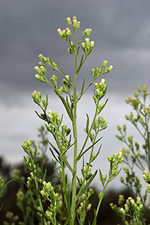|
||||||
|
CONYZA. Fleabanes. [Asteraceae] |
|
|
Six species of Conyza are recorded in Britain. These include the native Fleabane (C. canadensis x bonariensis) and the introduced Bilbao Fleabane (C. bilbaoana), Conyza blakei, Argentine Fleabane (C. bonariensis), Canadian Fleabane (C. canadensis), Japanese Fleabane (C. japonica) and Guernsey Fleabane (C. sumatrensis). Five British miners are recorded on Conyza. A key to the European miners recorded on Erigeron including Conyza is provided in Bladmineerders van Europa. |
|
Key for the identification of the known mines of British |
1a > Leaf-miner: Mine linear, whitish, both upper and lower surface. Pupation internal, at the end of the mine with the anterior spiracles projecting through the epidermis (Spencer, 1976: 433). Upper-surface, less often lower-surface corridor. Frass in isolated grains. Pupation within the mine, usually in a lower-surface puparial chamber. A long whitish upper surface corridor, which eventually goes lower surface. |
|
Chromatomyia syngenesiae Hardy, 1849 [Diptera: Agromyzidae]. |
1b > Leaf miner: A short linear mine in first instar, later producing a circular or oval blotch. Frass is excreted in a black mass prior to pupation; puparium firmly glued with frass within the mine (Spencer, 1976: 306). Large, whitish, upper-surface blotch, preceded by a short corridor that often is overrun later by the developing blotch. The larva hardly produces any frass; the few grains that are present are black and rather coarse. But when the larva is about to pupate, it empties its intestine, which has the effect that the puparium is anchored in the mine by dried frass. The initial gallery by the first instar larva then leads to a whitish blotch. The puparium is fixed to the inside of the mine by an accumulation of frass. |
|
Calycomyza humeralis (von Roser) [Diptera: Agromyzidae]. |
1c > Leaf-miner: A distinctive mine primarily above mid-rib, with irregular short lateral offshoots into leaf blade. Pupation external (Spencer, 1972: 51 (fig. 172), 55; Spencer, 1976: 270, 271 (fig. 486)). Branched, whitish, upper-surface corridor; main axis overlying the midrib; side branches overlying the main lateral veins. (In Campanula and Phyteuma the mine is much less branched, sometimes nothing more than a corridor on top of the midrib). Frass in rather long strings. Usually the mines begins as a long and narrow, shallow, tortuous lower-surface corridor that ends upon the midrib but otherwise is not associated with the leaf venation. Often this initial corridor is filled with callus, and then even less conspicuous. Pupation outside the mine. A linear mine on the upper surface, usually following the midrib and showing side branches along the veins. The frass is in strings. |
|
Liriomyza strigata (Meigen, 1830) [Diptera: Agromyzidae]. |
| 1d >
Leaf miner: An
irregularly linear mine which can be both on the upper and lower
leaf surface. Pupation takes place either at the end of the mine
in an exit slit cut in the leaf or on the ground (Spencer, 1972b: 70 (fig. 226), 73; Spencer,
1976: 407 (fig. 712), 408).
Upper surface corridor, often following the midrib for some distance. Frequently the very first part of the mine is lower-surface, and sometimes the entire mine remains at the lower surface. The corridor is wide from the start, with irregular sides. Frass initially in two rows of fine grains; further on the grains become larger and more irregular, sometimes forming pearl chains, and are dispersed less regularly. Pupation takes place either outside or within the mine. When the larva has left the mine a semicircular exit slit is made. When the puparium is formed within the mine the spiracles do not penetrate the epidermis, and an irregular semicircular opening is made in the epidermis in front of the puparium. Mines down the leaf from the tip, then doubles back and then mines towards the apex, often doubling back a second time, towards the leaf base. |
|
Phytomyza conyzae Hendel, 1920 [Diptera: Agromyzidae]. |
1e > Leaf-miner: A narrow upper surface linear branching mine without apparent feeding lines. Frass in isolated grains and pearl chains. At least in Erigeron older mines turn reddish-brown. Pupation external (Spencer, 1976: 413). |
|
Phytomyza erigerophila Hering, 1927 [Diptera: Agromyzidae]. |
| Last updated 02-Jul-2019 Brian Pitkin | ||

